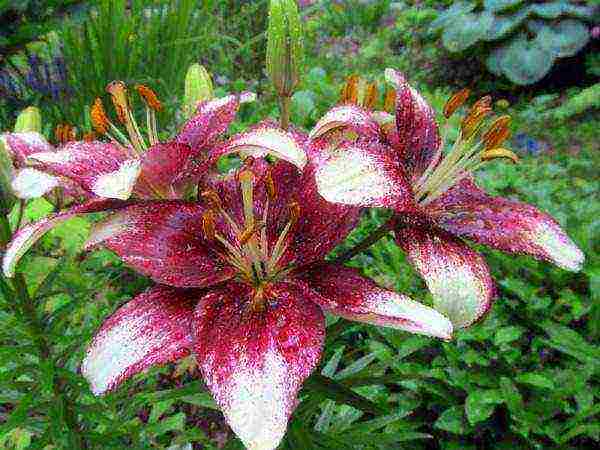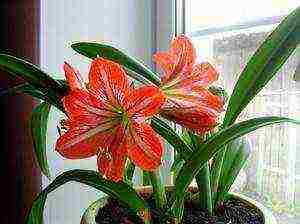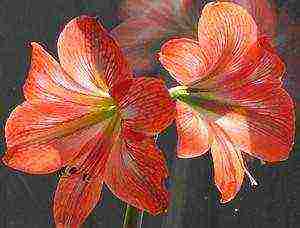Content
- 1 Getting ready to grow lily flowers in pots at home: photos of plants and the subtleties of preparation
- 2 How to plant a lily in a pot?
- 3 The subtleties of growing homemade lilies in a pot and caring for plants
- 4 How to grow and transplant oriental lilies in a pot?
- 5 Foreword
- 6 What should be a pot for a home lily
- 7 Preparing lilies for planting
- 8 How to plant a lily in a pot
- 9 How to care for potted lilies
- 10 What to do when the lily in the pot has faded
- 11 Types and varieties of room lilies
- 12 When to buy a home lily?
- 13 Landing rules
- 14 Indoor lily after flowering
- 15 Diseases and pests
Blooming plants in the house are a great opportunity to create a favorable cozy atmosphere and fill the air with amazing aromas. Home lily in a pot is currently not surprising with its presence, since special varieties of this plant have been bred, which are adapted to indoor conditions. First of all, these are oriental and Asian hybrids that give very few children and can grow without transplanting in one pot for several years. Growing homemade lilies in a pot is not as difficult as it might seem. There is an opportunity to regulate the flowering period and get beautiful large buds for any special occasion. To do this, you just need to choose the right planting time and provide the required conditions for growth.
A potted lily can grow up to 1.5 meters in height, or it can grow into a small, compact bush. To regulate the height of the stem, you need to select varieties. Well, and accordingly, the lily pot must meet the required agrotechnical conditions. The higher your future flower, the greater the height and diameter of the lily pot. So, with a stem height of 1.5 meters, the container should have a wall height of 35 - 40 cm. The volume of the seat for the 1st bulb is 16 cm2. Thus, 3-4 bulbs can be planted in a pot with a diameter of 40 cm. Single plantings in separate pots are not advisable, since lilies, with a large area of land around the bulb, begin to actively produce children, and flowering does not occur until the entire space is filled. This can take years.
Getting ready to grow lily flowers in pots at home: photos of plants and the subtleties of preparation
Look closely at the various photos of lilies in pots, the amazing beauty of these flowering plants bewitches and enchants. If the decision to plant them is made, then we are preparing to grow lily flowers in pots. The subtleties of preparing for growing lilies at home in a pot include several secrets:
- the correct choice of planting material - the bulbs must be strong and weigh at least 40 grams;
- decide on the varieties - preference is given to oriental, dwarf, Asian, royal and long-flowered species;
- stratify the bulbs in the refrigerator for 15 - 20 days - the temperature should be about 5 degrees Celsius;
- before planting, first soak the bulbs for 2 hours in a solution of potassium permanganate;
- then for 12 hours in a solution of nutrient fertilizers and growth stimulant.
A lily flower in a pot can be grown without replanting the bulbs for 2 to 3 years. For this, it is necessary to provide optimal conditions for the wintering of the plant. In no case should containers with planting material be taken out onto the balcony in winter. Unprepared bulbs can freeze. How to store after flowering and what to do to get abundant budding for the next season, we will tell below. In the meantime, we offer a few more colorful photos of lilies in pots on the balcony and windowsill:

How to plant a lily in a pot?
In order for something to start growing and developing, it is necessary to provide conditions for root growth and nutrition. Planting a lily in a pot involves choosing a suitable soil. It can be sod land mixed in equal proportions with humus or compost. When self-forming a soil mixture, do not forget about the addition of complex mineral fertilizers. As a rule, 50 grams is taken for each liter of soil. mixtures in equal proportions of nitrogen, potassium, magnesium and phosphorus. You can buy ready-made lily primer at the store. But before use, it must be disinfected. To do this, it is enough to spill the filled pots with boiling water with the addition of fungicides and potassium permanganate.
You can plant a lily in a pot at any time of the year. To obtain crops for summer decoration of balconies, it is necessary to plant the bulbs no later than the second decade of March. In this case, flowering will be ensured in the second half of May. For later dates of budding, it is necessary to repeat plantings with an interval of 2 weeks. To get flowers by December, you need to plant the lily in a pot at the end of September and provide additional lighting immediately after sprouting.
And now we will analyze in detail how to plant a lily in a pot at home:
- drainage is placed on the bottom of the tank in the form of sea and river pebbles or expanded clay, you can also use pieces of foam and broken brick, layer - up to 5 cm;
- then 10 cm of fertile soil is poured;
- the bulbs are laid out with their tops up, the bottoms are slightly pressed to the ground;
- from above, 15 - 20 cm of fertile land is poured;
- watering is carried out with warm water so that the soil is evenly moistened.
Before planting lilies, decide on the capacity and height of the sides of the pot. Taking into account the recommendations given above, calculate these parameters so that after planting there is about 7 cm space to the upper edge of the pot.
The subtleties of growing homemade lilies in a pot and caring for plants
You can get rich and long-lasting flowering only if all agrotechnical requirements are met. Growing lilies in pots is a fun and easy process. It is enough to provide full-fledged proper care of lilies in pots, to carry out regular watering and feeding with a balanced composition of mineral and organic fertilizers.
Let's figure out how to care for a potted lily. So, the planting was carried out correctly and successfully, now you need to wait for the sprouts to appear. For this period, a low temperature should be provided and watering should be carried out as the earthen coma dries up. This is about 1 time in 3 days.
In principle, a house lily in a pot does not require much care. After the shoots appear, the first feeding is carried out with a solution of organic fertilizers. After 7 days, re-feeding is carried out using a phosphorus-potassium composition. It is advisable at the time of initial growth to spray the sprouts with solutions with the addition of a growth stimulator. This is done about 2 times a week. This technique stimulates the formation of flower buds and ensures the development of large, colorful buds.
After the sprouts reach a height of 10 cm, the earth is filled up to the upper edge of the pot. Then, caring for a home lily in a pot is reduced to regular loosening of the soil to a depth of 5 cm to ensure the flow of fresh air to the root system. Watering is carried out daily. Top dressing with mineral and organic complexes for flowering plants at least 1 time per week. At the age of 1 month, a lily in a pot can be taken out into the open air. But this must be done with preliminary hardening. Carry out on the first day for 30 minutes, on the second - for 1 hour, on the third for 2 hours.And so the period of stay in the fresh air is gradually brought to 10 hours. Exposure to night temperatures below 10 degrees Celsius should be avoided. This inhibits the process of setting flower buds.
Until the buds bloom, caring for a home lily in a pot can be supplemented by daily spraying of the deciduous mass. This enables faster growth and development. In the open air, there is one rule to follow. During spraying and until the moisture dries, there should be no direct sunlight on the leaves. Otherwise it will cause sunburn. After blooming flowers, when spraying, you should avoid getting water on the petals. Moisture will shorten the flowering period.
If there are a lot of buds and they are heavy, then it is necessary to install supporting structures that will support the stem.
Take a look at a photo of potted lilies that you can successfully grow in your home with the effort and advice given above.
How to grow and transplant oriental lilies in a pot?
Recently, specialized stores have been selling potted oriental lilies in an already blooming state. How to preserve this beauty and continue the vegetative development of plants at home. First of all, you should know that caring for an oriental lily in a pot during its flowering period includes the obligatory abundant watering and fertilizing with mineral fertilizers. Spray the foliage at least once a day. This will maximize the flowering period.
You also need to know how to transplant a lily in a pot after the end of the flowering period.
To do this, it is necessary, after all the buds have fallen off, to wait until all the stems turn yellow and dry. In no case should you cut them off. At this time, it is necessary to reduce watering to 1 time per week. Each watering is combined with abundant fertilizing with mineral and organic fertilizers. Foliage spraying is completely stopped. It is important for us at this moment that all the nutrients accumulated in the foliage and stems are transferred to the bulbs and powerful flower buds are laid there for the next growing season.
After the aerial part is completely dry, watering stops completely and after 2 weeks there comes a time to dig up the lily bulbs. It is not worth leaving in the same land, since it is already depleted and will not allow the bulbs to fully develop the root system for the next year.
We take out the earthen lump from the pot and carefully disassemble it, taking out the bulbs. Children are best planted immediately in a separate container for growing planting bulbs. We wash large bulbs under warm running water and cut off the shoot at a height of up to 5 cm from the bulb. Then we put it in a container and fill it with a weak solution of potassium permanganate for 30 minutes. We take out and dry in the fresh air for 2 hours. Meanwhile, we prepare moss or sawdust, slightly moistening them and transferring them to a plastic bag. Mixing with sawdust there, add the onions. We put all this in a refrigerator or basement. This is how the bulbs are stored until the next planting.
Now you know how to grow lilies in a pot at home and have the knowledge of how to transplant bulbs correctly. Check out some more photos of lilies in pots:



Among indoor flowers, lilies with bright juicy greens, beautiful large flowers and a delicate aroma take pride of place. Of course, we are not talking about garden lilies, which can reach a height of one and a half meters or more. At home, a compact indoor lily of various types and varieties is grown in pots.
Foreword
For home cultivation, oriental, Asian hybrids, long-flowered lilies, golden, beautiful, dwarf, royal are used. In addition, indoor plants amaryllis and hippeastrum from the Amaryllis family are also popularly called house lilies, because their flowers are very similar to real lilies.
From the article, you will learn how to properly plant an indoor lily in a pot, how to care for indoor lilies in order to achieve abundant beautiful flowering, and what to do after the leaves fall. With proper care, an indoor lily flower can decorate the interior of your apartment, balcony or winter garden for a long time.
Video about planting and breeding lilies
Indoor lilies: planting and care according to all the rules
Since lilies at home, as in the garden, usually bloom from June to August, it is recommended to plant them in a pot in early spring. You can plant several bulbs at once in a flowerpot or in a tub, and then you will get a beautiful lush composition of lilies of different varieties and colors. For one bulb, a pot with a diameter of about twenty centimeters will be quite enough; a too spacious container may cause the lily to have no flowers.
A home lily flower will feel best in light fertile soil mixed with river sand. Lay drainage at the bottom of the pot, then add a layer of special soil mixture or soil enriched with nutrients, put the onion in the middle, gently spreading its roots to the sides. Fill the onion with soil mixture only up to half, while the earth should reach the middle of the pot. It will be possible to fill up the soil to the top after the stems have outgrown the edge of the pot.

A home lily flower will feel best in a light fertile land.
Before the shoots appear, the lily in the pot should be in a cool, dark place, and as soon as you see green shoots, transfer the plants to a windowsill or balcony. With the onset of summer, growing lilies at home continues in a cold place, where it is possible to provide the plants with an influx of fresh air.
Further caring for home lilies is not much different from caring for the garden representatives of this bulbous plant. Lilies will thrive and bloom profusely if you provide slightly moist soil and moist air. There is no need to transplant the flower into a larger container.
How to care for a room lily:
- water the plant regularly from the moment the shoots appear until the leaves dry in the fall, so that the ground does not dry out, but also not too wet;
- spray lily leaves with water from time to time;
- loosen the soil, adding peat, humus or leafy soil;
- remove weeds;
- when flowers appear, tie the stems to sticks.

In the future, you will need to remove the buds only from those plants that look weakened.
For a capricious plant like a lily, home care also includes liquid fertilizing. The first top dressing should be applied before the lily grows, the second - during the formation of buds, the third - until mid-August, after the lily blooms. The lily houseplant will be stronger and larger if you periodically add wood ash to the ground.
An equally gorgeous room lily, a photo of which is widely represented on the Internet, will most likely turn out for you in the second year. In the first season, it is better to remove everything at once so that the plant gains strength and gets stronger. In the future, you will need to remove the buds only from those plants that look weakened.
Now you know how to grow lilies at home, but keeping them until next season is not difficult: in the fall, the dead stems are cut off from the plant near the bulbs, the bulbs are taken out of the ground and placed in a bag with moist moss in the refrigerator for the winter or stored until spring in a layer of moisturized sand in the basement.

The bulbs are removed from the ground and placed in a bag with wet moss in the refrigerator for the winter.
How to care for home lily (amaryllis and hippeastrum)
Often, domestic lily flowers are confused, calling hippeastrum amaryllis and vice versa, although these indoor plants have a different flowering period and dormant period.It is better to immediately determine exactly what kind of home lily you have - caring for amaryllis and hippeastrum has some differences.
In appearance, it is not always possible to determine which genus the home lily belongs to, the photo can only confuse even more. You can find out the genus of the plant as follows: if your home lily blooms from summer to autumn, and is dormant in winter, then it is amaryllis. If flowers appear from winter to spring, and the plant rests in summer, this is hippeastrum. Accordingly, it will be necessary to plant and transplant the bulbs during the dormant period of the indoor flower.
Both hippeastrum and amaryllis thrive in warm, illuminated places, but they perceive direct sunlight and overheating very poorly. In summer, it is advisable to take plants out into fresh air, providing protection from precipitation. Twice a month, amaryllis are fed with mineral fertilizers, and for hippeastrum they alternate between organic and mineral fertilizers.
Video about growing lilies in the country
Like many other indoor flowers, the lily loves wet cleaning of the leaves for hygiene purposes. Watering is necessary moderately, as the soil dries up, just do not flood the plant, since amaryllids are easily affected by rot when waterlogged. During the flowering of the home lily, watering is increased, and during the dormant period, it is reduced.
If the indoor lily receives proper care, it is less likely to be affected by diseases and pests, outwardly the plant looks healthy and strong. With a lack of watering and waterlogging of the soil, the lily leaves become lethargic and pale, the flowers begin to darken from the cold, and from the excess of the sun they turn pale. Pay close attention to how your room lily looks in order to take the necessary measures in time, and then bright beautiful flowers will decorate your apartment for a long time!
Rate the article:
(4 votes, average: 4.3 out of 5)
Many lilies can be grown at home in a pot. But in order to achieve lush flowering, it is necessary to take into account the important features of these plants and properly care for them.
In summer, a lily in a pot will perfectly decorate a windowsill, balcony or terrace. The main thing is that there is a lot of sunlight, otherwise the flowers will lose their decorative effect. And the plant also needs fresh air, so it is recommended to take it out into the garden in good weather.
Any lily can grow in a pot, but growers prefer Asian and Oriental hybrids. Currently, special pot varieties have also been developed (for example, Garden Party, Miss Rio). They grow short (up to 30-40 cm).
What should be a pot for a home lily
For growing lilies at home, you can use almost any type of container: an ordinary flower pot, a spacious ceramic flowerpot, a plastic box. The size of the container depends on the number of bulbs you plan to plant and the type of lily.
The pot must be large enough and deep enough for the plant to develop properly. The higher the flower, the wider and deeper the container should be. You also need to take into account that too light containers are not suitable for a lily. Otherwise, the container may fall under the weight of the tall stem and flower. If the container is made of thin plastic, a weighty drain (for example, pebbles) should be placed on the bottom to make it heavier.
With a stem height of 1.5 m, the height of the pot wall should be at least 35-40 cm. The volume of the planting space for one bulb is 16 sq. Cm. Thus, 3-4 bulbs can be planted in a pot with a diameter of about 40 cm. Planting in separate pots is rarely practiced because lily bulbs are actively growing children until all the necessary space of the earth is filled, and until that moment they bloom.
Preparing lilies for planting
For growing lilies, a mixture of turf soil with humus or compost in a 1: 1 ratio is ideal. To make things easier for yourself, you can buy a ready-made primer for these flowers. But keep in mind: before planting, any soil must be spilled with a solution of potassium permanganate or boiling water for disinfection.
The bulbs must also be prepared in advance. They are first dipped in a pink solution of potassium permanganate for 1-2 hours, and then soaked in any growth stimulator (for example, Epine) for 10-12 hours. But if you are in no hurry to get a flowering plant, you can do without the last procedure.
The bulbs can be planted at any time, but it is better to do this at the same time as when planting in open ground (in April) or a little earlier (in early March). Then in late spring - early summer you can already admire the flowering of charming lilies.
How to plant a lily in a pot
Drainage (sea or river pebbles, broken brick, expanded clay) is poured onto the bottom of the container with a layer of 5 cm, and on top of it is a previously prepared fertile soil with a layer of 10 cm. On the surface of the earth, the bulbs are laid out with the bottom down, straightening the roots. Fertile soil is poured on top with a layer of about 20 cm. After that, the soil is slowly watered with warm water so that it is evenly saturated with moisture.
When planting lily bulbs in a pot, keep in mind that the earth is not poured to the top. About 7 cm should remain to the edge of the container, since as the stem grows, it will be necessary to add soil to the pot, which will cover the overgrown roots.
How to care for potted lilies
Caring for a lily in a pot is simple, but without some procedures it is impossible to achieve abundant flowering. After planting the bulbs, the soil in the pot is watered as the earthen coma dries up (usually every 3 days). It is advisable to keep the plants in a cool place until sprouts appear (at a temperature of 10-15 ° C).
After germination, lilies can be fed with organic matter, but this is not necessary if you used fertile soil when planting. If the lily receives enough light, but still grows very slowly, it should be sprayed with a growth stimulant solution. This procedure is recommended to be carried out 1-2 times a week. It stimulates not only the growth of shoots, but also the laying of flower buds.
When the stems reach a height of 10 cm, soil is poured into the pot. After that, caring for the plants is reduced to timely watering and loosening the soil to a depth of about 5 cm, so that air flows to the roots.
Once a week, it is useful to feed the lily with a liquid complex fertilizer for flowering plants (according to the instructions for a specific preparation).
At the age of 1 month, in good weather, the lily can be taken out into the garden or on the balcony, but the plant must be accustomed to this gradually. On the first day, the flower should "breathe" fresh air for no more than 30 minutes, and when the plant gets used to it, it can be left outside for up to 10 hours. In the warm season, lilies are taken home only at night, because the air temperature below 10 ° C inhibits the process of laying flower buds.
Until the buds form, it is useful to spray the lily leaves daily with water at room temperature. But at this time the sun's rays should not fall on the plants. Otherwise, burns may occur. You can continue spraying after the flowers have bloomed, but it is important to make sure that no water drops fall on the petals. In addition, during flowering, tall lilies may need supports to help the stems hold the heavy flowers.
What to do when the lily in the pot has faded
After the buds dry and fall off, watering is reduced to 1 time per week, and the leaves stop spraying. At this time, it is important that all the nutrients accumulated in the leaves and stems are transferred to the bulbs, therefore, in no case should the aerial part of the lily be cut off immediately after the end of flowering. It is necessary to wait until the leaves and stems themselves turn yellow and dry.
After the dying off of the aerial part, the bulbs stop watering, and after 2 weeks they are dug up and placed in storage. It makes no sense to leave lilies in this pot, since the soil in it is already depleted. In the next season, she will not be able to provide the bulbs with the necessary nutrients.
It is better to plant the children in a separate container for growing, and the adult bulbs are washed under warm water, the stem is cut at a height of up to 5 cm, placed in a container with a solution of potassium permanganate and kept there for 30 minutes. Then it is dried in the fresh air for 2-2.5 hours. Then a slightly moistened moss, peat or sawdust is placed in a plastic bag and bulbs (1-2 pieces) are placed there.
The bag is stored in a refrigerator or basement at a temperature of about 5 ° C until next spring.
Some growers leave the bulbs in pots, but this storage method is less preferable: the planting material can get sick, dry out or rot, but you will not see it. In addition, in the spring, it is still better to transplant the bulbs into fresh soil, although less fastidious lilies can germinate in the next season and even bloom in the same soil. But risk-averse growers usually store lily bulbs in a cool place in a bag with a damp substrate.
 Among home flowers, plants with rich greenery, beautiful large flowers with an extraordinary aroma take pride of place - all this is a lily. Naturally, in indoor conditions, medium-sized garden samples are grown, and small compact species that fit in pots. Although the house lily has a fairly short flowering period, it is readily grown.
Among home flowers, plants with rich greenery, beautiful large flowers with an extraordinary aroma take pride of place - all this is a lily. Naturally, in indoor conditions, medium-sized garden samples are grown, and small compact species that fit in pots. Although the house lily has a fairly short flowering period, it is readily grown.
After all, it serves not only as part of the interior, but also often turns into a collectible.
Types and varieties of room lilies
The plant is classified according to the structure of their flower:
- The flowers are in the shape of a bowl, wide open. Such petals are possessed by the following varieties: Gilded Lily, Beautiful Lily, Empress Lily of China. The Grand Commander variety is considered one of the best.
- The petals are funnel-shaped, collected in a tube. Similar flowers can be seen in varieties that are more extensive: Royal Lily, Long-flowered Lily, Royal Gold and others. Their flowers range in color from pale yellow to bright orange. The house lily also belongs to this species.
- Flowers with bent petals. This group does not differ in the variety of varieties, as is the case in other species. The size of the plants is quite small - up to 60 cm, the flowers are also small - the diameter is only about 5 cm. The varieties L. Citronella and the dwarf lily are common.
Indoor lily: home care
 When growing garden and indoor crops, air humidity and temperature are of no small importance. Different varieties have their own level of tolerance to high and low temperatures and photosensitivity.
When growing garden and indoor crops, air humidity and temperature are of no small importance. Different varieties have their own level of tolerance to high and low temperatures and photosensitivity.
- Asian hybrids are recognized as the most unpretentious in terms of care.
These plants have the longest stem, and the flowers are distinguished by fancy colors with specks, spots, stripes. NSthat group grows well in an area bathed in sunas well as in partial shade. They require moderate watering, more or less resistant to parasites and diseases. They have one drawback - the lack of smell, but this minus of Asian hybrids is compensated by the beauty of the colors.
- Curly hybrids grow in moist soil enriched with leafy humus, shade is suitable for them. They are also famous for their excellent resistance to cold and disease.
- The most beautiful varieties of lilies are recognized as snow-white hybrids. Any beauty is accompanied by moodiness, so they are very demanding in their care.
- Long-flowered hybrids are known by another name - house lily. Since they are often grown as a houseplant. Lily fell in love with many thanks to its large flowers and rich aroma.Moreover, the plant is demanding to care for and prone to disease, so growing in the garden is problematic. On the windowsill, home culture feels much more secure with proper care. It is important to ensure that a spider mite does not appear on the flower.
When to buy a home lily?
 Indoor crops are bought in the form of a bulb because it is a bulbous plant. Autumn is the best season. Pay attention to the condition of the tuber: if you find scales, spots, wrinkles, then it is not suitable for planting. If such signs are not found, disinfection is still carried out. Malofos or manganese solution can act as an antiseptic.
Indoor crops are bought in the form of a bulb because it is a bulbous plant. Autumn is the best season. Pay attention to the condition of the tuber: if you find scales, spots, wrinkles, then it is not suitable for planting. If such signs are not found, disinfection is still carried out. Malofos or manganese solution can act as an antiseptic.
An indoor plant usually has shoots and leaves on sale, sometimes even a flowering plant is sold, so in order to extend the flowering period it is fed with special fertilizers, it is important not to overdo it with watering.
Landing rules
They choose a pot, soil, do not forget about good drainage. It is quite simple to grow an indoor lily in a home. They are planted in the substratespecially formulated for bulbous plants, a light soil enriched with nutrients and having good drainage properties is also suitable.
The bulb should take the central position of the pot, the distance to the walls should be within 3 cm. Cover with soil until the middle of the bulb. After that, the well-being of the plant will depend on the time that is given for the dormant period and the air temperature.
Room lily
With the correct cultivation of a bulbous plant, a home culture can delight with flowering at different times of the year.
Domestic lily belongs to the genus hippeastrum and amaryllis, therefore, it really needs warmth and light during the flowering period, and during rest they prefer darkness and coolness. That's why the best place will be a sun-drenched windowsill... On hot days, it is better to keep the windows open, since this houseplant, like all amaryllis, needs a stream of fresh air, especially after sunset.
Watering should be reduced after the flowers fall, external conditions change radically: light replaces shadow, moist heat turns into dry coolness. If you follow a similar scheme for growing a room lily, then you can achieve repeated flowering.
Indoor lily after flowering

Domestic lily refers to flowers that do not so often and do not delight the owners with their beauty for a long time. but you can achieve an increase in the flowering period and add its number... It all depends on the storage period of the plant when it is in a state of sleep.
So, after flowering, the home lily is placed in a dry, cool place. Can be transplanted into new soil with the addition of ash. It should occasionally pamper the bulb with top dressing and watering, then in a state of active growth, problems with flowering will not arise.
Diseases and pests
If the plant is well cared for, the likelihood of disease is reduced. Among the most common diseases is red bulb rot. This disease develops in wet and cold conditions. To save the bulbsoil that interferes with pruning of affected areas, including affected roots, should be removed. After the procedure, all exposed sides are treated with a fungicide and sprinkled with crushed activated carbon. Then the bulbs are dried for 3 days, and the watering intensity is reduced.
Plant parasites can cause irreparable damage to the plant. Among the most common pests that attack not only lilies, but all domestic flowers are: spider mites, mealybugs, scale insects. Actively insecticides destroy these insects... However, it is best to prevent them from occurring with proper care. For example, a spider mite appears due to the increased dryness of the air; its appearance can be prevented by creating humid conditions.
If the house lily is well cared for, it is rarely affected by pests and diseases, and the plant looks healthy and robust. Leaves become lethargic and pale due to excess or lack of moisture, the flowers turn dark from the cold, and when the sun is too hot, the color becomes pale. Therefore, you should carefully monitor the state of the room lily and take appropriate measures in time, then the beauty of flowers will decorate your home for a long time.


